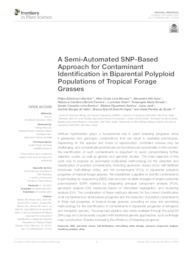A semi-automated SNP-based approach for contaminant identification in biparental Polyploid Populations of tropical forage grasses.
A semi-automated SNP-based approach for contaminant identification in biparental Polyploid Populations of tropical forage grasses.
Autoria: MARTINS, F. B.; MORAES, A. C. L.; AONO, A. H.; FERREIRA, R. C. U.; CHIARI, L.; SIMEÃO, R. M.; BARRIOS, S. C. L.; SANTOS, M. F.; JANK, L.; VALLE, C. B. do; VIGNA, B. B. Z.; SOUZA, A. P. DE
Resumo: Artificial hybridization plays a fundamental role in plant breeding programs since it generates new genotypic combinations that can result in desirable phenotypes. Depending on the species and mode of reproduction, controlled crosses may be challenging, and contaminating individuals can be introduced accidentally. In this context, the identification of such contaminants is important to avoid compromising further selection cycles, as well as genetic and genomic studies. The main objective of this work was to propose an automated multivariate methodology for the detection and classification of putative contaminants, including apomictic clones (ACs), self-fertilized individuals, half-siblings (HSs), and full contaminants (FCs), in biparental polyploid progenies of tropical forage grasses. We established a pipeline to identify contaminants in genotyping-by-sequencing (GBS) data encoded as allele dosages of single nucleotide polymorphism (SNP) markers by integrating principal component analysis (PCA), genotypic analysis (GA) measures based on Mendelian segregation, and clustering analysis (CA). The combination of these methods allowed for the correct identification of all contaminants in all simulated progenies and the detection of putative contaminants in three real progenies of tropical forage grasses, providing an easy and promising methodology for the identification of contaminants in biparental progenies of tetraploid and hexaploid species. The proposed pipeline was made available through the polyCID Shiny app and can be easily coupled with traditional genetic approaches, such as linkage map construction, thereby increasing the efficiency of breeding programs.
Ano de publicação: 2021
Tipo de publicação: Artigo de periódico
Unidade: Embrapa Gado de Corte
Palavras-chave: Allele dosage, Apomictic clones, Clustering analysis, GBS, Half sibling, Self fertilization, Shiny
Observações
1 - Por padrão são exibidas publicações dos últimos 20 anos. Para encontrar publicações mais antigas, configure o filtro ano de publicação, colocando o ano a partir do qual você deseja encontrar publicações. O filtro está na coluna da esquerda na busca acima.
2 - Para ler algumas publicações da Embrapa (apenas as que estão em formato ePub), é necessário ter, no celular ou computador, um desses softwares gratuitos. Sistemas Android: Google Play Livros; IOS: iBooks; Windows e Linux: software Calibre.
Acesse outras publicações
Acesse a Base de Dados da Pesquisa Agropecuária (BDPA) para consultar o acervo completo das bibliotecas da Embrapa.

